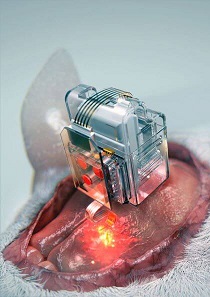A device implanted into mice can modulate brain circuit activity over long periods of time.
Nicoletta Lanese
Aug 7, 2019
Awireless device implanted in mouse brains can deliver drugs and photostimulation directly to the tissue—and employs smartphones as its remote control, researchers reported August 6 in Nature Biomedical Engineering. The invention couples an ultrathin probe, about the thickness of a human hair, with tiny LEDs, microfluidic channels, and replaceable drug cartridges that can be easily swapped out. The authors aim to develop the technology for use in humans, overcoming the limitations of conventional drug delivery and optogenetics.
The device could also be modified to extract liquids from the brain, which would grant it diagnostic utility, according to a commentary in journal highlighting the research. Crafting gadgets that marry neural stimulation with diagnostics could someday enable the “fabrication and operation of permanent ‘cyborg-like’ brain-enhancement devices for maintaining healthy neural function or even boosting neural aptitude,” the authors write.
R. Qazi et al., “Wireless optofluidic brain probes for chronic neuropharmacology and photostimulation,” doi:10.1030/s41551-019-0432-1, Nature Biomedical Engineering, 2019.
Nicoletta Lanese is an intern at The Scientist. Email her at nlanese@the-scientist.com.


